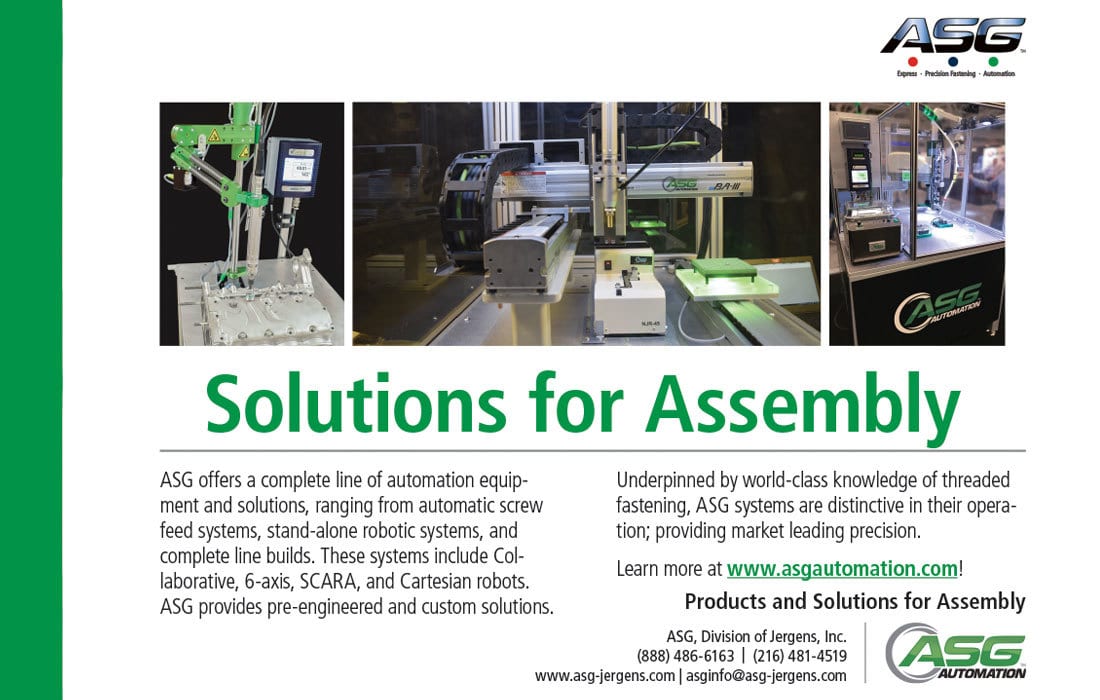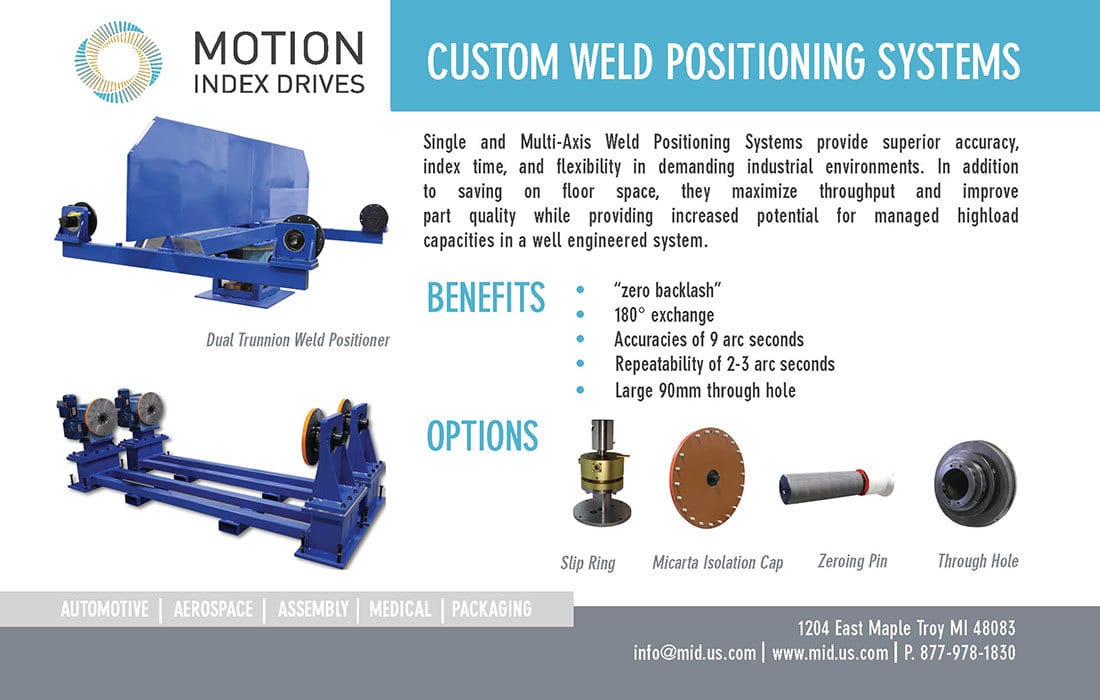Machinery Assembly
Austin Weber // Senior Editor // webera@bnpmedia.com
Industry 4.0 technology and robotics enable manufacturers to improve output, quality and safety.
Machinery Makers Invest in Automation
Construction equipment manufacturers are investing in automation and Industry 4.0 technology. Photo courtesy Komatsu Ltd.
Demand for “big iron” is booming, fueled by the rebounding global economy and the Biden administration’s infrastructure initiative. That’s good news for manufacturers of tractors and other types of agricultural and construction equipment. The bad news is the post-pandemic labor shortage, which is causing headaches and creating bottlenecks.
To address the issue, AGCO, Caterpillar, CNH Industrial, Deere, Doosan, JCB, Kubota, Komatsu, Liebherr, Terex, Volvo and other companies are investing in automation and Industry 4.0 technology, such as additive manufacturing, artificial intelligence, augmented reality, automated guided vehicles (AGVs), collaborative robots, digital twins and predictive analytics. The goal is to improve throughput, quality and safety.
“With the COVID-19 pandemic continuing to impact the industry, Internet of Things (IoT) technology will be a go-to for manufacturers looking to maintain efficiency and productivity,” claims a recent report by the Association of Equipment Manufacturers (AEM). “[It] will drive value for the industry by allowing organizations to make measured, informed decisions using real-time data in an effort to increase efficiency and positively impact their bottom lines.”
Demand for agricultural equipment is expected to be strong in 2022. Photo courtesy CNH Industrial
Stronger-than-expected growth last year has many manufacturers feeling optimistic about 2022. In fact, more than 80 percent of AEM members anticipate rising demand for agricultural and construction equipment over the next year. Specifically, 65 percent predict that demand for agricultural machinery will be above normal, while 44 percent believe demand for construction equipment will be above normal.
“The American Jobs Plan will give a big boost to spending on infrastructure,” says Benjamin Duyck, director of market intelligence at AEM. “The biggest impacts will be in 2022 and 2023.”
Despite that positive outlook, more than 80 percent of AEM members are having a difficult time filling positions in their factories. More than three-quarters (82 percent) of construction equipment manufacturers are facing labor shortages, as are 87 percent of agricultural equipment manufacturers.
Automation Investment Addresses Labor Shortage
Artificial intelligence and 5G technology will drive future manufacturing activity at John Deere. Photo courtesy Deere & Co.
Many heavy machinery manufacturers are investing in automation to compensate for a lack of workers and to maximize the production capacity of current facilities.
“Even before the onset of COVID-19, labor shortages were the single biggest challenge to manufacturers,” says Matthew Rendall, CEO of OTTO Motors, a leading supplier of autonomous mobile robots. “The pandemic and resultant safety protocols have exacerbated an already dire situation.
“Automation has long been a desire to help drive efficiencies, but today it is a mandate,” claims Rendall. “A ‘nice to have’ automation strategy has become a ‘need to have’ [priority]. Without automation to fill in the gaps for missing labor, these businesses are in real trouble.
“In addition, for decades U.S. and Canadian-based manufacturers have seen business head south of the border [to take advantage] of reduced labor costs,” notes Rendall. “Autonomous mobile robots (AMRs) have the ability to flip that script and allow manufacturers to realize lower operating costs and increased competitiveness. In a post-COVID world where localization is the latest trend, U.S. and Canadian businesses now have access to innovative [technology] that increases competitiveness and mitigates labor shortages.
Stronger-than-expected growth last year has many machinery manufacturers feeling bullish about 2022 and 2023. Photo courtesy CNH Industrial
“Agricultural and construction manufacturers are [typically] less mature than other manufacturing sectors with respect to automation,” Rendall points out. “In automotive manufacturing, for example, high-mix low-volume facilities often benefit from AMRs because of their need for flexibility in mission-critical tasks.
“Assembly processes [in the machinery industry often] include larger or more valuable components that benefit from the reduction of WIP that comes from rapid and consistent delivery on AMRs,” explains Rendall.
One equipment manufacturer that has benefitted from automation is Kubota Manufacturing of America Corp. (KMA), which operates several factories in Georgia.
“We’ve purchased many different brands of AGVs in recent years and we’re currently using about 160 machines for material handling applications, including just-in-time parts delivery,” says Brian Arnold, vice president of operations at KMA. “However, some of the devices are built in-house by our manufacturing engineering department.
“We’ve developed lost-cost technology that enables us to deploy AGVs in many types of applications,” explains Arnold. “We typically purchase the drive kits, then integrate things such as the frame structure and safety controls to meet our unique needs.
“Some of our sister plants in Japan are very automated, especially the engine assembly facilities,” adds Arnold. “But, our U.S. tractor factories rely heavily on manual processes. Everything we produce is built to order, so the volume and diversity of our product line just doesn’t lend itself to fully automated systems.”
Industry 4.0 Helps Reduce Human Errors
One of the goals of Industry 4.0 technology is to empower operators to be more productive without compromising safety. It allows assemblers to do what they do best while enabling better throughput and quality.
“In general, the agricultural and construction equipment industry tends to [make products] that are much larger in size compared to other manufacturing sectors,” says Paul Ryznar, CEO of LightGuide Inc., a company that specializes in augmented reality technology. “Takt times are also much longer, increasing the risk that critical steps may be accidentally skipped or performed out of order, resulting in downstream rework.
“Machinery manufacturers are looking for ways to leverage Industry 4.0 technology to tackle challenges throughout the manufacturing process,” explains Ryznar. “Some of these challenges include quality, productivity, throughput, operational visibility and training.
“With Industry 4.0 becoming more prevalent, [manufacturing engineers] ae searching for practical [ways to solve plant floor challenges] as quickly, efficiently and completely as possible,” claims Ryznar. “One of the best ways of utilizing Industry 4.0 technology is to limit or remove human error through the standardization of processes. With [projected augmented reality technology], we’re able to translate past issues, such as ‘tribal knowledge,’ into a repeatable and interactive process.
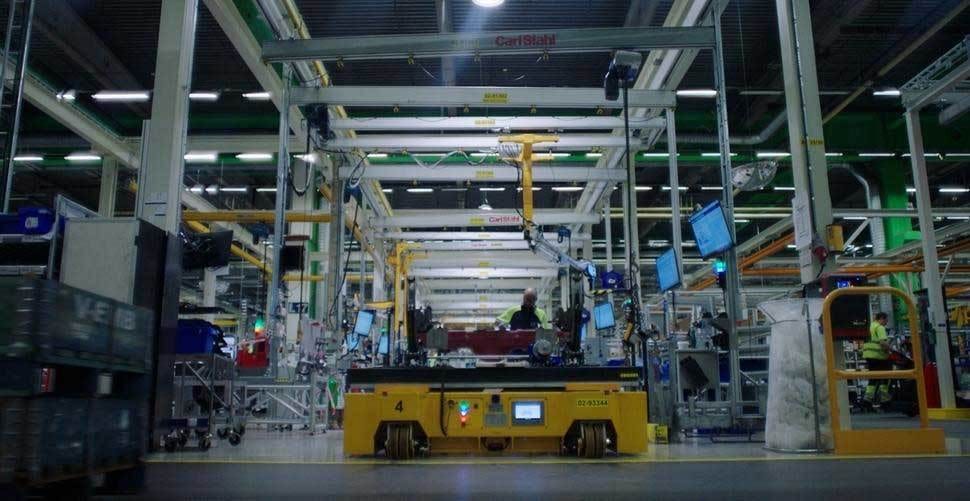
Volvo Construction Equipment’s Factory 4 Tomorrow initiative is exploring new technologies that make manufacturing more sustainable. Photo courtesy Volvo Construction Equipment
“Assembly lines are often fast-paced environments susceptible to human error,” says Ryznar. “Anything that can be done to limit or remove this human error is key in driving quality and productivity. By converting traditional paper- or monitor-based work instructions into an augmented and interactive environment, [engineers] we can improve throughput considerably, and effectively eliminate quality concerns at the workstation.”
“The biggest benefit of Industry 4.0 is that you’re able to leverage data like never before,” adds Ed Garibian, CEO of LLumin Inc., an operations software company that produces products such as READYAsset and READYTrak. “The organizations leveraging it—the ones that know how to use it and have the right software and people in place to get the most from their data—are going to win the game.
“[Machinery manufacturers] can do more with what they have,” claims Garibian. “They can communicate better, compliance is smoother, maintenance is efficient and they can automatically trigger actions based on that data. This enables people to do more with less. It provides knowledge-sharing at every step of the way.
“Rear-view mirror data leads to reactive and expensive practices,” explains Garibian. “Using real-time data is a game-changer when margins are slight and competition is steep.”
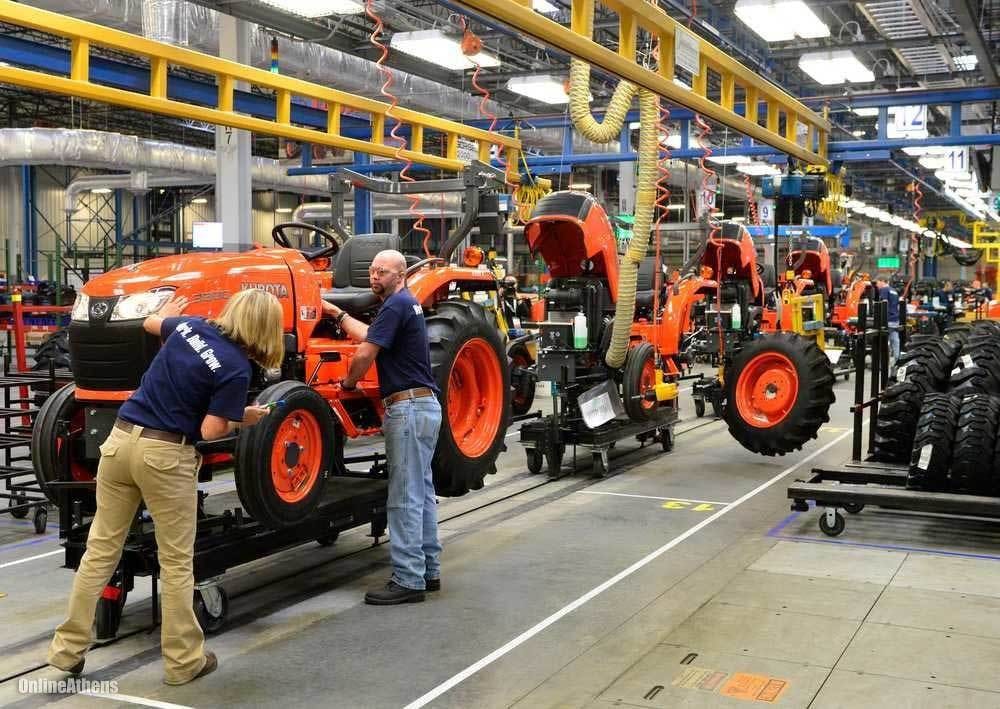
Machinery manufacturers are investing in automation to maximize the production capacity of current facilities. Photo courtesy Kubota Manufacturing of America Corp.
“With industry 4.0, you can collect a lot of information from different sources in assembly plants,” adds Maziar Adl, chief technology officer at Gocious, a cloud-based software system for manufacturers with complex product lines. “As a result, you gain more knowledge and transparency on what’s happening across your operation to make better decisions and help take the correct action. The other benefit is digital transformation.
“The ongoing issues emerging from globalization, supply chain disruptions and the pandemic are forcing an increase in automation adoption and the improvement of digital tools available for manufactures,” notes Adl. “Enabling more advanced automation through industry 4.0 [can enable engineers to] remotely manage and maintain their factories to make them more resilient.”
CNH Industrial Sees Big Role for Cobots
Agricultural manufacturers are looking for ways to leverage Industry 4.0 technology to improve quality and productivity. Photo courtesy Deere & Co.
CNH Industrial is a leading producer of agricultural and construction equipment, with popular brands such as CaseIH, New Holland and Steyr. The company is also at the forefront of applying automation and Industry 4.0 technology. In fact, it’s in the midst of implementing a global smart factory initiative that is focused on deploying state-of-the-art AGVs and collaborative robots.
“We want to minimize the risk to workers and also improve their physical well being,” says Peter Ommeslag, head of Industry 4.0 at CNH Industrial. “Cobots and AGVs reduce the potential for accidents, while also decreasing the physicality of day-to-day work.
“Efficiency is the main focus of our activity,” explains Ommeslag. “But, we also consider other aspects to make jobs even easier and to change the way we go about manufacturing, by introducing new technologies, a new culture and new skills into our production lines.
“We’ve found that cobots substantially minimize the previous difficulties our staff endured,” claims Ommeslag. “They can be used by employees with disabilities and those using wheelchairs, which is great.
The Biden administration’s infrastructure initiative is good news for construction equipment manufacturers. Photo courtesy Caterpillar Inc.
“With aging workforces becoming more common, cobots will allow people to work longer and more safely,” Ommeslag point out. “They are a very intuitive technology, so people don’t need extra training. As the technology continues to evolve, cobots have huge potential for learning new skills in the future.”
“We are working together with our sister plants around the globe to adapt the latest Industry 4.0 tools,” adds Bill Baasch, vice president of manufacturing at CNH Industrial North America. “As we develop, learn and grow, we continue to apply new automation and technology.
“We view a ‘smart factory’ as a facility where technology is able to self-optimize, self-configure and self-diagnose equipment, letting us know when issues may be arising,” explains Baasch. “When machines talk back to us, we can avoid problems before they arise.
“We have installed sensors and predictive analytics software in our production equipment,” says Baasch, who is responsible for managing operations at 11 CNH Industrial factories that produce a wide variety of agricultural equipment. “That allows us to monitor things such as shaft vibrations in machining centers. We also look for temperature increases that might indicate that a bearing or some other type of critical part is wearing out, plus spikes in electricity, gas and air pressure.
“Automation and Industry 4.0 technology helps us improve productivity and employee safety in our assembly plants,” Baasch points out. For instance, he says collaborative robots are used on repetitive tasks such as parts feeding.
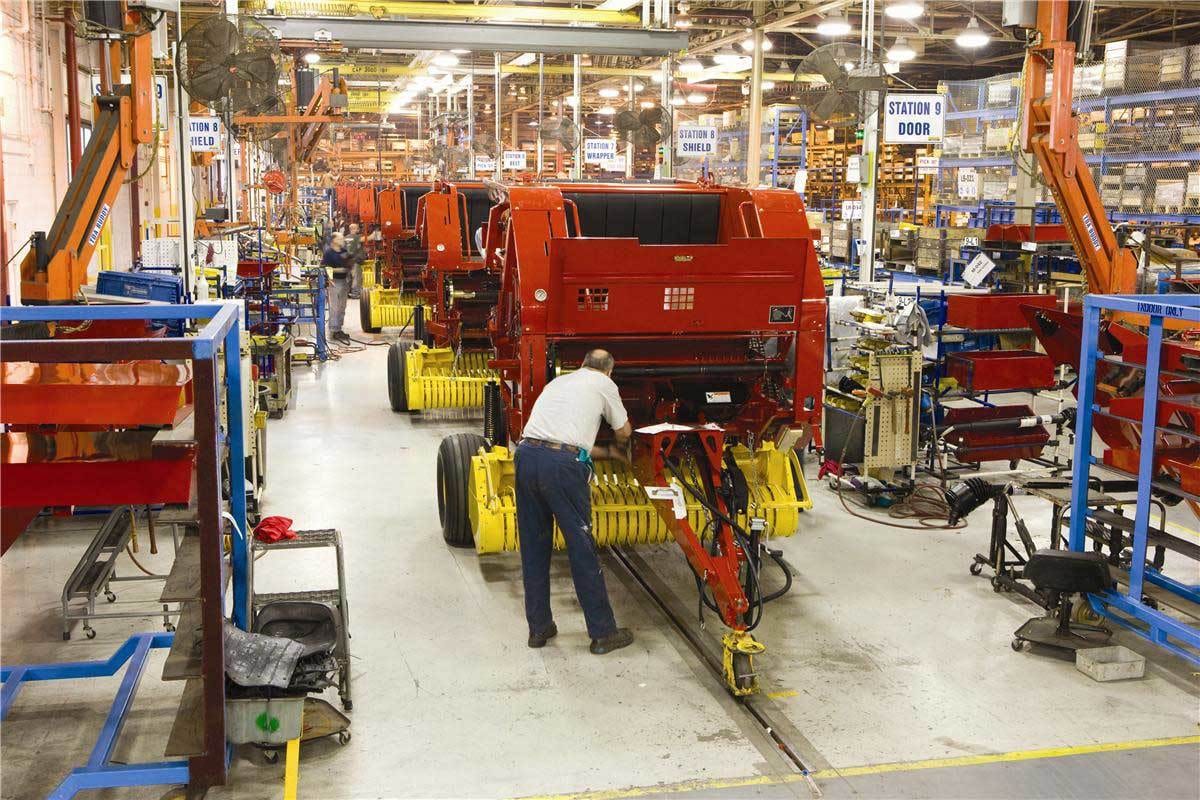
CNH Industrial is at the forefront of applying automation and Industry 4.0 technology in its factories. Photo courtesy CNH Industrial

Collaborative robots enable humans and machines to safely work in close proximity. Photo courtesy CNH Industrial
“Most of our facilities also use AGVs throughout their production processes to standardize logistics routes and safely deliver parts,” says Baasch. “That frees up labor that is very hard to get today.
“The labor market has been a big challenge for us,” explains Baasch. “To address the issue, we’ve looked at some augmented reality technology where we can get operators exposure and experience before they actually step foot on the factory floor. It also helps us address quality issues.”
In particular, CNH Industrial has harnessed virtual reality technology to train welders. In addition to teaching both new hires and veteran welders alike in a safe environment, costs are reduced because parts and materials aren’t scrapped or wasted.
“We’ve been able to successfully implement automation and Industry 4.0 technology at various facilities,” says Baasch. “Once we’ve successfully piloted and tested an application, we try to roll it out to other plants.”
Baasch and his colleagues have applied lessons learned to several factories throughout North America. For instance:
The Grand Island, NE, plant that produces combine harvesters and windrowers piloted augmented reality welding simulation to train operators.
The New Holland, PA, factory that produces implements such as balers, mowers, rakes and spreaders piloted a project involving assembly line cobots.
The tractor plant in Racine, WI, uses AGVs to transport transmissions from subassembly lines to the final assembly line.
The Wichita, KS, facility that makes construction equipment piloted a project with sensors that enable machining centers and welding robots to perform self-diagnosis tasks.
CNH Industrial has also experimented with additive manufacturing and digital twins.
“We have used digital twin technology for material handling applications to optimize parts picking,” explains Baasch. “At our Wichita plant, we’ve used an ergo suit to measure and record operator movements. That helps with ergonomic risk assessment and analysis.
“Additive manufacturing has also been extremely beneficial to us and plant floor applications will continue to grow in the future,” claims Baasch. “Most of our plants are equipped with 3D printers that produce fixtures, jigs and gauges. We’ve also printed decal placement guides and part mockups.
“Additive manufacturing has been an integral part of our design enhancements and has been essential to improving product quality,” says Baasch. “It’s very helpful to be able to put a part or tool in your hand in just a few hours, and then be able to physically see it and touch it.”
CNH Industrial engineers are also using 3D printers to create miniature mockups of plant layouts and assembly lines.
Deere Invests in 5G and AI
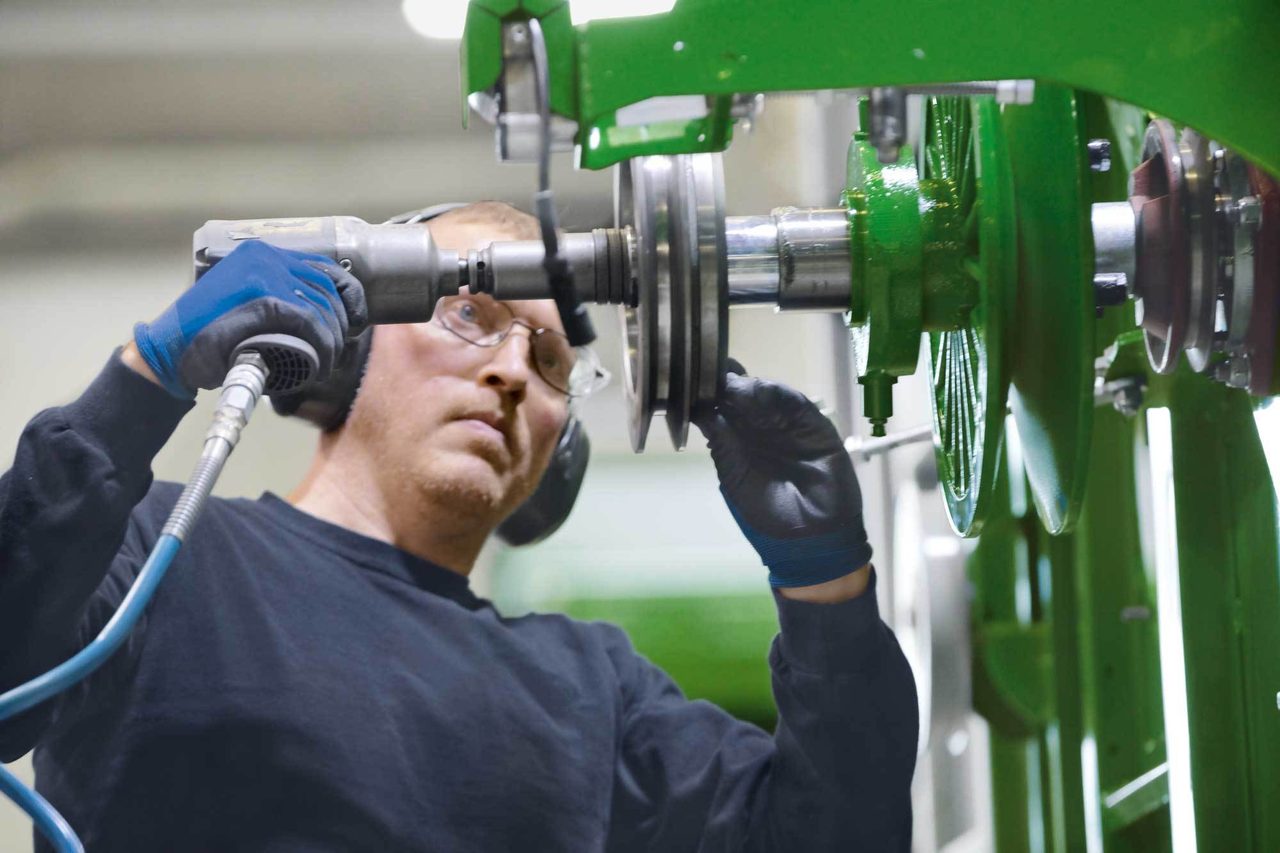
Most machinery manufacturers have been affected by the labor shortage. Photo courtesy Deere & Co.
Artificial intelligence and 5G technology will drive future manufacturing activity at Deere & Co. The machinery giant is in the process of installing 5G in its factories to transform the way that conveyors, fastening tools, robots and other production equipment perform and interact. The 5G initiative will power numerous Industry 4.0 initiatives, improving the automation of production processes and real-time monitoring of machine conditions.
The technology will enable Deere to connect multiple devices at once and move more data faster than ever. As 5G is adopted, it will improve the ability of engineers to deploy artificial intelligence (AI), data analytics, digital twins and other smart factory tools. It will also enable millions of devices, such as actuators, cameras, motors and sensors, to be connected wirelessly with each other.
“John Deere has always focused on how to empower customers to do more with less by using technology, and our focus on tech goes way beyond the fields,” says Jahmy Hindman, chief technology officer at Deere. “It impacts every single aspect of our business, and we’re constantly looking at ways to improve our own efficiencies and outcomes with it.
Flexibility and speed of change are becoming more important to construction equipment manufacturers. Photo courtesy Volvo Construction Equipment
“Implementing 5G in our manufacturing facilities [will allow us] to make significant progress in our Smart Industrial strategy by turning factories into connected manufacturing facilities, a critical piece of IoT,” claims Hindman. “[Our] manufacturing facilities are extraordinarily complex environments that rely on automation and connectivity.
“With miles of embedded Ethernet cables connecting Wi-Fi drop points currently in factory ceilings, the facilities are faced with limited flexibility for set up and upgrades,” explains Hindman. “5G enabled by private networks will allow [us] to design a more flexible, nimble and connected facility, creating opportunity for further advancement and greater efficiency that will transform the manufacturing process.
“Private 5G technology also creates the opportunity to expand factory capabilities leveraging edge computing, analytics and autonomous devices," adds Hindman. “[It] empowers a larger set of smart applications like real-time location systems, asset tracking, inventory management, wearables, building automation and robotics for operational cost savings.”
Deere also sees big potential for AI technology. In fact, it recently partnered with Intel Corp. on a project to improve robotic welding applications. The system uses a computer vision system from Adlink Technology Inc. to automatically spot common defects in the automated welding process.
The integrated, end-to-end system of hardware and software can generate insights at levels beyond the human sense’s capability. When using a neural network-based inference engine, the system logs defects in real time and automatically stops the welding process.
Additive manufacturing enables engineers to create mockups of plant layouts and assembly lines. Photo courtesy CNH Industrial
“Deere is using computer vision, where a video stream is processed through an industrial PC (IPC) to deliver real-time analysis that inspects welds for defects,” says Ricky Watts, industrial segments director at Intel. “Use of a hardened camera is required, due to the harsh environment associated with welding temperatures and other environmental variables.
“The camera is aimed at the robotic welder’s puddle, and has a frame rate and resolution that enables the IPC to interrogate the weld’s quality with an algorithm trained with previous welding images,” explains Watts.
“The combination of the camera’s streaming video into the IPC, which is running this algorithm, enables a robotic welder to cease welding within a half of a second of defect detection, helping eliminate rework and improving quality of welds,” Watts point out. “This is especially valuable for the multiple-pass welds associated with many of Deere’s machines.
“All data available to manufacturers is being considered in new ways, thanks to AI,” claims Watts. “Real-time detection of product defects and worker safety, yield improvement, machine predictive maintenance, and other improvements are now possible with the use of AI. The availability of ubiquitous, reduced-cost compute capabilities can analyze massive amounts of data, including image, video, time series, text and audio.
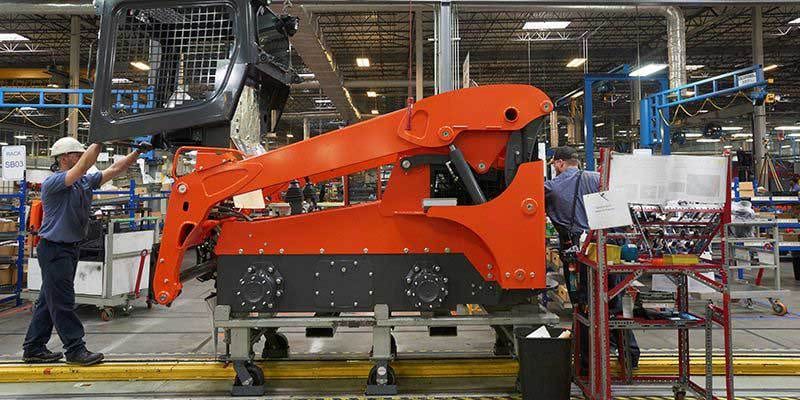
Agricultural and construction equipment manufacturers traditionally rely on manual assembly processes. Photo courtesy Kubota Manufacturing of America Corp.
“The real-time inspection of an assembly can help ensure quality or completeness prior to the assembly being integrated into another, higher-value assembly,” says Watts. “This significantly reduces rework, inspection times and disruption of processes associated with subassemblies.”
“Welding is a complicated process,” adds Andy Benko, quality director for Deere’s construction and forestry division. “AI has the potential to help us produce our high-quality machines more efficiently than before. The introduction of new technology into manufacturing is opening up new opportunities and changing the way we think about some processes that haven’t changed in years.”
Deere uses gas metal arc welding (GMAW) to fabricate thousands of mild- to high-strength steel parts that are used to assemble its green and yellow machines.
“One common welding challenge felt across the [machinery] industry is porosity, in which cavities in the weld metal are caused by trapped gas bubbles as the weld cools,” explains Benko. “The cavities weaken the weld strength.
Agricultural equipment is typically assembled in low-volume, high-mix facilities. Photo courtesy CNH Industrial
“Traditionally, GMAW defect detection has been a manual process requiring highly skilled technicians,” says Benko. “Past attempts to deal with weld porosity issues during the welding process haven’t always been successful. If these flaws are found later in the manufacturing process, they require rework or even scrapping of full assemblies, which can be disruptive and expensive.”
According to Benko, traditional manual inspection methods require highly skilled operators who rely on visual and auditory indicators. These inspectors are expensive, difficult to find and face numerous challenges when detecting defects in factory environments.
Using a neural network-based inference engine, the AI system can not only detect defects in real time, but also automatically stop the welding process via robotic actuation before the defect is prolonged and the part is damaged beyond repair. It can also be retrained to detect additional types of defects in the welding process.
Volvo Implements ‘Factory 4 Tomorrow’
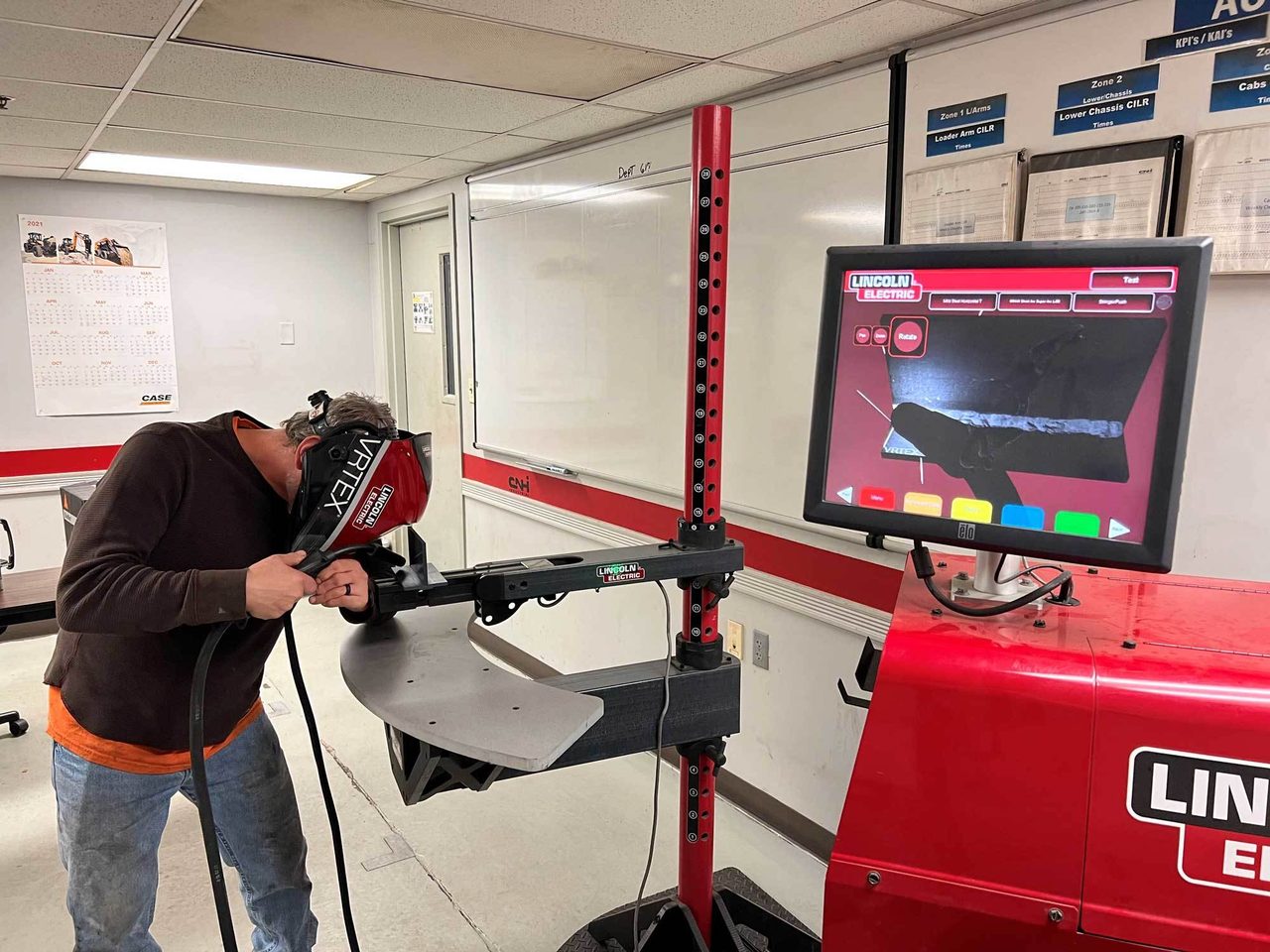
CNH Industrial uses virtual reality technology to train welders. Photo courtesy CNH Industrial
Volvo Construction Equipment recently implemented an Industry 4.0 initiative dubbed Factory 4 Tomorrow (F4T). The goal of the global effort is to explore new technologies to make manufacturing more sustainable.
“[We are] embracing change and putting the power for innovation directly in the hands of [our] employees with F4T,” says Lina Stålberg, head of manufacturing technology development and governance at Volvo CE. “Factory 4 Tomorrow is about far more than just introducing new technologies; there’s a far higher purpose behind it. It’s about building a world we want to live in and workplaces we want to work in.”
Across 14 production sites around the world, smart factory teams have been set up, tasked with looking for ways to innovate and impact the business. The teams are actively seeking ways to solve everyday business problems and challenges with the help of Industry 4.0 technology such as AI.
“They will be experimenting and testing new ideas and ways of working,” explains Stålberg. “It will be a complete overhaul of every production detail, and the innovations that are explored could very well become a reality on the factory floor in the coming years. Automation in the factories will reduce the need for employees to engage in repetitive tasks, creating a safer and more ergonomic work environment.”
“As well as creating an attractive workplace, Factory 4 Tomorrow will transform [our] manufacturing processes, delivering significant benefits for customers, many of whom are demanding more customization and more individualized products,” adds Brunno Muller, head of advanced manufacturing engineering and research at Volvo CE.
New Heavy-Duty Press Shapes Bulldozer Blades
Beckwood Press Co. recently delivered a 50-ton gib-guided bulldozer press to Haven Steel Products Inc. It will be used to bend and straighten heated steel to form industrial rotary blades. Haven Steel is a leading fabricator of heat-treated steel components used by agricultural and construction equipment manufacturers.
The side-acting press features an eight-point square gib-guidance system that minimizes lateral movement under load to ensure parallelism throughout the cycle. Presence-sensing safety mats and a hydraulically actuated unloading mechanism provide additional protection from the heated parts.
The custom press is integrated into a fully automated workcell that includes a preheat oven, part handling robots and an automated chute. Automation integration of the press with a custom part loading machine and unloading mechanism was performed by Techam Solutions. The automation sequence coordinates a robust machine tending function for the press.
“The press is an integral part of the overall automation project,” says Tom Oxley, special projects manager at Haven Steel Products. “[It enables] parts to be formed and directly inserted into the heat-treat process untouched by human hands. The [system] improves workplace safety, work environment, productivity and quality.”
“We are continuing to see an increase in automation requests from press users in nearly every industry,” adds Caleb Dixon, sales manager at Beckwood Press. “By working with both the integrator and the end user on this project, we were able to ensure the press met Haven Steel’s production needs, while providing Techam with the programming infrastructure it needed to incorporate the automation components.”
“Thanks to globalization and new technologies, flexibility and speed of change are becoming more important,” claims Muller. “A digital transformation will accelerate [our] lean journey toward operational excellence. Optimized manufacturing will also bring sustainability benefits, helping to reduce [our] industrial footprint.
“Industry 4.0 is about digitalization of the industry to better utilize data to add value to our business,” says Muller. “Advanced manufacturing technology is part of our F4T journey and we continuously investigate different applications.”
According to Muller, Volvo CE is pursing the following initiatives in its assembly plants:
Inspection by vision. “By using cameras and machine learning, we can detect quality characteristics and improve logistics triggering points (parts availability) in an autonomous and efficient way,” says Muller. “We can also process quality checks without human intervention.”
Jig-free welding. “Welding robots and material handling robots collaborate to optimize the welding process, reduce material waiting time and increase the efficiency of our processes,” explains Muller.
Advanced analytics and predictive maintenance. “We are using sensors to capture various equipment data, such as temperature, vibration and voltage,” notes Muller. “With advanced analytics, we create models to predict and anticipate breakdowns. We are moving from time-based maintenance to condition-based maintenance.”
Robotic Process Automation (RPA) for production planning. “Repetitive tasks carried out by employees in production planning and verification have been supported by our RPA to reduce nonvalue adding activities,” says Muller. “Employees can [now] focus more on value-adding tasks.”
Virtual manufacturing for new product development and process validation. “We utilize virtual labs to validate products in early stages of development, thus reducing lead time and cost,” claims Muller. “Virtual labs are also used to improve process validation, such as paint robot programming and simulation.”
Additive manufacturing. “We use 3D printing to create new fixtures to support continuous improvement and to prototype parts during product changes,” says Muller.
ASSEMBLY ONLINE
For more information on machinery manufacturing, visit www.assemblymag.com to read these articles:
